|
|
Population
and Ethnic Groups
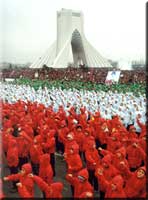 According
to the latest census made in 1996, the population of Iran was a little more
than 60 million of which about 37 million were urban dwellers and about 23
million villagers and a small percentage are nomad tribes. The Majority of
urban dwellers live in major cities like Tehran, Meshed, Isfahan, Tabriz,
Shiraz, Qom, Ahwaz, Rasht, Orumyeh, and Kerman shah. According
to the latest census made in 1996, the population of Iran was a little more
than 60 million of which about 37 million were urban dwellers and about 23
million villagers and a small percentage are nomad tribes. The Majority of
urban dwellers live in major cities like Tehran, Meshed, Isfahan, Tabriz,
Shiraz, Qom, Ahwaz, Rasht, Orumyeh, and Kerman shah.
More
than half of the population of the country is active population and about
39.5% of total populations are below 14 years of age. Thus, the population
of Iran is one of the youngest among other countries of the world. So, the
society of Iran is full of adolescence emotion and joy. From employment
point of view, age distribution of employed population of 10 years and
above in different economic sectors is 23.04% in agriculture, 44.5% in
service, and 30.7% in industry. Total employed population of the country
is reported at about 14.5 million.
Out
of total population of the country with 6 year of age and above, 79.51% are
literate. The rate of literacy in urban areas is 96.88%, and in rural
areas is 91.37% of people deserving to be learned (6-14 years). This ratio
is 84.66% among men and 74.21% among women. In urban areas this ration is
89.56% and 81.7% and in rural areas is 76.74% and 62.41% for men and women
respectively.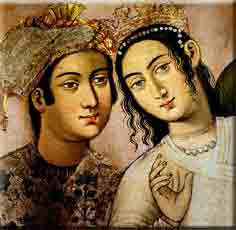
Tourists,
especially regular ones, are very interested in visiting the decampment of
nomad tribes. This can be attributed to many reasons. The main reason is
the fact that these nomad tribes have well safeguarded their old tradition
and culture. Generally, the present life style of nomads in Iran, is not
so different from our ancient predecessors. Therefore, visiting the nomad
tribes and recognition of their life style, especially decampment between
winter and summer quarters, will help them get acquainted with the life
and culture of ancient Iranians.
Iran
is situated on the way of Central Asia and Turkey as well as western
countries and different ethnic groups live
over
there. Among them Farsis, Kurds, Lors, Balooches, Bakhtiaris, Azaris,
Turks,
Taleshs, Turkmans, Ghashghais, and Arabs may be pointed out. Smaller
ethnic groups also live in Iran. Turkamans, who live in Turkman Sahara and
north of Khorasan, are different from other Iranian ethnic groups from
appearance, language and cultural points of view. Ghashghais, who have
Turkish origin, live in central part of Iran. Arab clans mostly live in
Khuzestan and are scattered along the coastlines of the Persian Gulf.
Today, the composition of Iranian ethnic groups is considerably mixed due
to development and expansion of communication system and more interaction
and association of people, resulting in a relatively uniform social
environment.
Some
groups of colored people, who are the descendants of slave trade with
Zanzibar, are scattered in southern provinces of Iran. The existing Indian
minority in the south of Iran is also the posterity of Indian traders in
past times.

 Religion
and culture Religion
and culture
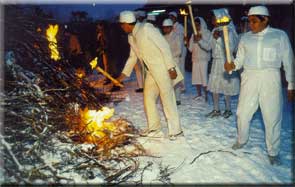 Iran
is the birthplace of Zoroaster, one of the oldest prophets of the world
and founder of Zoroastrian religion. The official religion of Iran, based
on Article 12 of the constitution, is Islam (Shiite), and about 99.56% of
people are Muslims. Disciples of other branches of Islam like Hanafi,
Maleki, Shafei, Hanbali, and Zaidi in Iran are highly respected and live
freely without any Iran
is the birthplace of Zoroaster, one of the oldest prophets of the world
and founder of Zoroastrian religion. The official religion of Iran, based
on Article 12 of the constitution, is Islam (Shiite), and about 99.56% of
people are Muslims. Disciples of other branches of Islam like Hanafi,
Maleki, Shafei, Hanbali, and Zaidi in Iran are highly respected and live
freely without any
 limitation. In the Constitution of I.R.Iran, religions
of Zoroastrian, Christian, and Jewish are recognized officially and their
disciples have equal political, social and economic rights like Muslims.
Religious minorities of Zoroastrian, Armenian, Jewish, Assyrian, and
Chaldean have their own independent representatives in the Islamic
Consultative Assembly (the Parliament). limitation. In the Constitution of I.R.Iran, religions
of Zoroastrian, Christian, and Jewish are recognized officially and their
disciples have equal political, social and economic rights like Muslims.
Religious minorities of Zoroastrian, Armenian, Jewish, Assyrian, and
Chaldean have their own independent representatives in the Islamic
Consultative Assembly (the Parliament).
Cultural
richness of Iran in different arenas like different eastern art,
literature and Gnosticism has global reputation. Iranian myths, fictions,
philosophy, poetry, music, folklore, handicrafts, architecture, and
decorative arts are important parts of human thoughts.

 Travel
and transportation Travel
and transportation
 The
best means for travel to Iran is airplane. The major international
airlines, especially Iran Air (Homa), have regular flights between Tehran
and large cities of the world. Almost all international airlines have
independent branch offices in Tehran. The
best means for travel to Iran is airplane. The major international
airlines, especially Iran Air (Homa), have regular flights between Tehran
and large cities of the world. Almost all international airlines have
independent branch offices in Tehran.
Travel
to Iran is possible by other means of transportation such as car through
neighboring countries such as Turkey, Iraq, Turkmenistan, Azerbaijan,
Armenia, Pakistan, and Afghanistan. The main roads, which connect Iran to
neighboring countries, are as follows:
*Iran-Turkey
in Bazargan border city, northwest of Iran;
*Zahedan-
Mirjaveh in the Iran-Pakistan border, *sout-east of Iran;
*Taybad-
Harat in the Iran- Afghanistan border, east of Iran;
*Astara-Jolfa
in the Iran-Azarbaijan border, north of Iran;
*Ghasre’shirin-khosravi
in the Iran-Iraq border, west of Iran. *
Moreover, Iran is connected to northern countries by waterways through
northern ports located on the coasts of the Caspian Sea as well as
littoral states of the Persian Gulf and sea of Oman and the Indian Ocean
through southern ports.
There
are asphalt connecting roads between major cities with suitable quality.
The driving system in Iran is based on international driving regulation
and through right lane. So many of roads in Iran are mountainous with
eye-catching views. There are internatioal traffic signs in all main roads
while they are controlled by highway patrols. 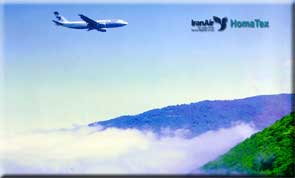
The
capital cities of all provinces and other major cities are linked together
through a network of main roads. There are also asphalt access roads among
other cities of a province. The main transit roads have
northwest-southeast or west-east direction and connect Iran-Turkey border
to Iran-pakistan border as well as northern countries to inside of Iran.
The up-to-date road maps of Iran can be easily obtained through all bookshop,
tourism offices, and newspaper stands.
In
mountainous roads of Iran, there is speed limitation, but most of roads in
Iran are relatively safe. There is no need for taking spare gasoline due
to the existence of enough gas stations along all roads specially the main
ones. The price of gasoline (normal and unleaded) and gas oil is very low
in Iran compared to other countries.
Travel
by bus is very cheap in Iran due to low price of gas oil. In addition,
there are different bus companies with well-equipped and comfortable buses
and various classifications to all around Iran. There are also other
facilities for travel like minibuses, rent a car from agencies, etc., most of
them centered in the bus terminals of the cities. The Islamic Republic of
Iran Railroad, like other countries in the world, has regular passenger
train services to some major cities like Tabriz, Meshed, Gorgan, Isfahan,
Kerman, Yazd, Ahwaz, and Khoramshahr.
There
are regular flights to all major cities as well as to small ones by the
Islamic Republic of Iran airline ( Homa ), Iran Air Tour, SAHA, Aseman
Airline, Mahan air, and Caspian Air. Development of the airports Of the
country in last years made possible the wide and suitable air connection
of the cities. The fare of domestic flights is very cheap compared with
other countries.

 Hotels
guesthouses and other Hotels
guesthouses and other
Accommodation
Facilities
There
are different accommodation facilities in Iran with diverse classification
with reasonable prices like hotels, motels, guesthouses, inns, hostels,
etc. for
 the welfare of tourists, a series of hotels or guest houses have
been established by Iran Tourism Organization in several tourism regions
or even in remote cities with suitable and healthy services and reasonable
prices all equipped with necessery services like restaurant, teahouse, air
conditioner, and parking with pleasing atmosphere. Other suitable tourist
facilities like tourist complexes and camping sites are available in
several locations. the welfare of tourists, a series of hotels or guest houses have
been established by Iran Tourism Organization in several tourism regions
or even in remote cities with suitable and healthy services and reasonable
prices all equipped with necessery services like restaurant, teahouse, air
conditioner, and parking with pleasing atmosphere. Other suitable tourist
facilities like tourist complexes and camping sites are available in
several locations.
Restaurants
are very different in Iran due to their famous cooking styles, very
diverse and delicious for everybody's taste. In the cities, all kinds of
local and national dishes as well as international ones are served. The
traditional café in Iran isGhahveh Khaneh (coffeehouse) but in which tea
is served not coffee. In ghahveh khaneh, in addition to tea and hubble-bubble,
a famous national food called Abgoosht is served. These traditional teaho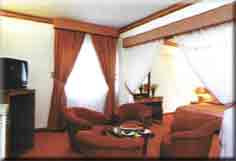 uses are worth-seeing places. In the past, these Ghahveh Khanehs
played an important role in the social life of the people and spending of
their leisure time. Today, these Ghahvah Khanehs have more or less their
social role and the gathering places of different social groups and
centers for exchange of news and information. Formerly, for more
attraction of people to these places , many different programs like
jugglery , storytelling, reciting of Shahnameh , animal shows and some
artistic activities were performed. There are some Ghahveh Khanehs, which
entertain their customers with old styles of entertainment. A lot
ofGhahveh Khanehs exist along main connection roads, which supply simple
services. uses are worth-seeing places. In the past, these Ghahveh Khanehs
played an important role in the social life of the people and spending of
their leisure time. Today, these Ghahvah Khanehs have more or less their
social role and the gathering places of different social groups and
centers for exchange of news and information. Formerly, for more
attraction of people to these places , many different programs like
jugglery , storytelling, reciting of Shahnameh , animal shows and some
artistic activities were performed. There are some Ghahveh Khanehs, which
entertain their customers with old styles of entertainment. A lot
ofGhahveh Khanehs exist along main connection roads, which supply simple
services.
There
are many restaurants between cities, which supply different foods both
local and national.

|
|